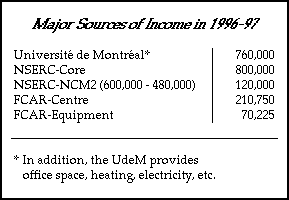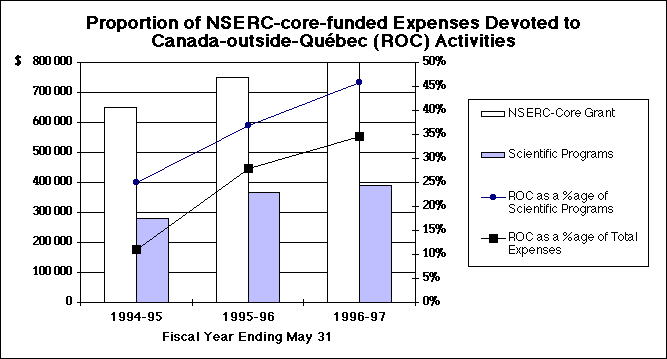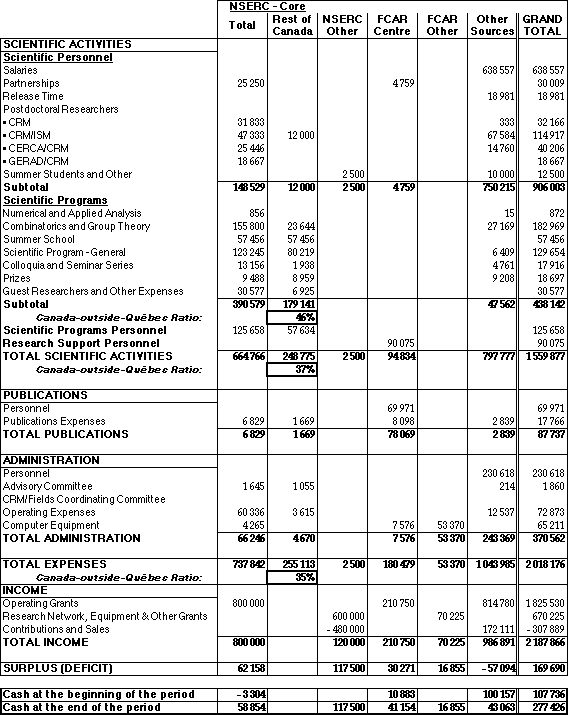

The financial year of the CRM starts on June 1 and ends on May 31. The Financial Statement presents, on a cash-flow basis, the major expenses and income of the CRM during 1996-1997, as well as its financial position at the beginning and at the end of the period. The overall results have been broken down into three major column groups representing the following sources of financing: the National Science and Engineering Research Council of Canada (NSERC), the Fonds pour la formation de chercheurs et l'aide à la recherche du Québec (FCAR), and Other sources.

During 1996-1997 the CRM received Income (presented at the bottom of the Statement) from the following sources. NSERC-Core: $800,000 in core operating grant to pursue its national mandate (a 6,7% increase over the $750,000 received the previous year); this level of funding is expected to be maintained over the next two years (1997-1999). NSERC-Other: the first $600,000 annual installment of a $3million five-year research network grant for the newly created ncm2 (Network for Computing and Mathematical Modeling); ncm2 funding is being shared with four other research centres: the CERCA (Centre de recherche en calcul appliqué), the CIRANO (Centre interuniversitaire de recherche en analyse des organisations), the CRT (Centre de recherche sur les transports) and the GERAD (Groupe d'études et de recherche en analyse des décisions); ncm2 financial management is largely decentralized, and these four centres have been allocated $480,000 of the total $600,000; of the $120,000 remaining in the Financial Statement, $90,000 represents the share of the CRM, and $30,000 is a fund dedicated to centralized activities and which is being managed by the CRM on behalf of the ncm2. FCAR-Centre: the first $210,750 annual installment of a three-year operating grant from its Research Centre program (a 23,6% increase over the $170,500 received the previous year); such an increase in funding is quite remarkable given the 25% decrease in average FCAR funding for centres of the same category as the CRM. FCAR-Other: $70,225 in a computer equipment grant to be used over the three-year period ranging from 1996 to 1999. OTHER Sources: a substantial grant of $760,000 was received from the Comité d'étude et d'administration de la recherche (CEDAR) of the Vice-rectorat à la recherche of the Université de Montréal (a 1,5% decrease over the $771,300 received the previous year); other important sources of income include the Canadian Institute for Advanced Research (CIAR), the McConnell Foundation, and Dr. André Aisenstadt who is the CRM's major benefactor; finally, the CRM earns revenues from the publication of books in the American Mathematical Society (AMS) series and in its own home publications program, as well as from registration fees it charges for attending scientific activities.
The Expenses of the CRM are presented under three major categories: Scientific Activities, Publications, and Administration. Major items of the Scientific Activities include the Scientific Personnel: remuneration of Université de Montréal professors who perform research in-residence at the CRM, the expenses associated with the release of professors from Montréal-based universities so that they can perform work at the CRM, and the remuneration of postdoctoral researchers and summer students; the Scientific Programs: the 1996-1997 theme year in Combinatorics and Group Theory as well as some expenses from the previous theme year (Numerical and Applied Analysis), the Banff Summer School of 1996 related to the theme year in Combinatorics and Group Theory as well as the advance payment on the 1997 Summer School, the General Scientific Program, mainly constituted of contributions of the CRM to off-site scientific activities, the Colloquia and Seminar Series organized jointly with the Montréal-based Institut des Sciences Mathématiques (ISM), expenses associated to three prizes for excellence in the mathematical sciences: the André-Aisenstadt Prize, the Canadian Association of Physicists (CAP)-CRM Prize, and the CRM-Fields Institute Prize, and finally expenses related to guest researchers; the Scientific Programs Personnel directly involved in the management of the programs, and the Research Support Personnel directly involved in providing UNIX system services and preprint publications support to the researchers. The Publications item includes the remuneration of personnel dedicated to the Publications program as well as the direct expenses related to it. Finally, the Administration portion of the Financial Statement includes: the remuneration of personnel of the Director's Office, Administration and Services to Researchers and Administrative Computer Systems, the expenses related to the meetings of the Advisory Committee and CRM-Fields Institute Coordinating Committee, the operating expenses, and computer equipment and maintenance expenses.
The National Mandate of the CRM is reflected in the NSERC-Core column of the Financial Statement labeled as Rest of Canada . Under this heading are singled out those NSERC-Core-funded expenditures of the CRM which occurred in Canada, but outside of Québec. Such expenses include the Summer School in Banff, numerous off-site scientific events sponsored by the CRM (often in collaboration with the Fields Institute and the Pacific Institute for the Mathematical Sciences), and the expenses related to non-Québec Canadians visiting the CRM in order to participate in its scientific programs. The ratio of such Canada-outside-Québec expenses to the overall NSERC-Core-funded expenses is: 46% for the Scientific Programs only (compared to 37% last year), and 35% (compared to 28% last year) for the total expenses funded by NSERC-Core. This ratio of 35% is well above the threshold of 25% once suggested by the CRM-Fields Institute Coordinating Committee in an earlier report.
Concerning the Results and Financial Position, the CRM has recorded an overall surplus of $169,690 during the period (compared to a deficit of $3,588 last year), which has increased its financial cushion from $107,736 at the beginning of the period to $277,426 at the end (a cushion representing 13% of its total income for the year). It is important to realize, however, that excluding the ncm2 funding by NSERC and FCAR equipment grant, the CRM overall surplus would have been $35,335 during the period, which would have increased its financial cushion from $107,736 at the beginning of the period to $143,071 at the end (a cushion representing 7% of its total income for the year, excluding ncm2 and FCAR equipment grants). The reason for the substantial surplus on the ncm2 fund is that the NSERC installment was received on March 31, 1997, only two months before the end of the 1996-1997 CRM fiscal year. The detailed results show that major accounts have been brought closer to equilibrium during the year. A surplus of $62,158 for the period has brought the CRM's NSERC-Core-account accumulated deficit back from $79,176 two years ago and $3,304 last year to a surplus of $58,854 this year. A surplus of $30,271 for the period has been allowed to bring the CRM's FCAR-account accumulated surplus position from $10,883 to $41,154, which will facilitate the allocation of large administrative expenses in future years. Finally, a deficit of $57,094 for the period has brought the CRM's OTHER-Sources-account accumulated surplus down from $204,670 two years ago and $100,156 last year to $43,062 this year.


27 March 1998, webmaster@CRM.UMontreal.CA